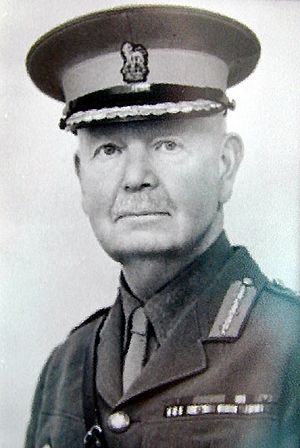George Grogan facts for kids
Quick facts for kids
George William St George Grogan
|
|
|---|---|
 |
|
| Born | 1 September 1875 Devonport, Devon |
| Died | 3 January 1962 (aged 86) Sunningdale, Berkshire |
| Allegiance | United Kingdom |
| Service/ |
British Army |
| Years of service | 1896–1926 |
| Rank | Brigadier General |
| Unit | West India Regiment Worcestershire Regiment |
| Commands held | 5th Brigade 3rd Battalion, Worcestershire Regiment 238th Infantry Brigade 23rd Brigade 2nd Battalion, Worcestershire Regiment |
| Battles/wars | Hut Tax War of 1898 First World War Russian Civil War |
| Awards | Victoria Cross Companion of the Order of the Bath Companion of the Order of St Michael and St George Distinguished Service Order & Bar Mentioned in Despatches (8) |
| Relations | Admiral Sir William King-Hall (grandfather) |
| Other work | Gentleman at Arms |
Brigadier General George William St George Grogan (born September 1, 1875 – died January 3, 1962) was a brave officer in the British Army. He is famous for receiving the Victoria Cross. This is the highest award for courage a soldier can get in the face of the enemy in Britain and the Commonwealth.
Contents
Early Military Life
George Grogan went to school at Haileybury and Imperial Service College. He also studied at the Royal Military College, Sandhurst. These schools helped him prepare for a career in the army.
In 1896, he joined the West India Regiment. He served in Sierra Leone during the Hut Tax War of 1898. This was a conflict over a new tax. Later, he worked with the Egyptian Army for five years. In 1908, he joined the Worcestershire Regiment.
World War I Hero
When World War I began, George Grogan was promoted to major. He joined the British forces fighting in France. In January 1915, he was injured. After the Battle of Neuve Chapelle, he took command of a battalion as a temporary lieutenant colonel.
He received the Companion of the Order of St Michael and St George (CMG) award in 1916. This award recognized his excellent service. He was also mentioned in official reports for his good work.
Bravery at the Somme
Grogan fought in the terrible Battle of the Somme in 1916. For his bravery, he received the Distinguished Service Order (DSO) in 1917. This award is given for great leadership and courage.
His award citation said he showed "conspicuous gallantry and devotion to duty." It also mentioned how he visited dangerous trenches to give instructions. His courage and cheerful attitude greatly inspired his soldiers.
More Courage, More Awards
During a difficult retreat in March 1918, Grogan showed even more bravery. He received a Bar to his DSO. This means he got the award a second time.
The citation for this second award highlighted his personal efforts. It said he helped keep the battle line strong when other troops were pulling back. He would go to the front lines himself when things were critical. His amazing example of courage inspired everyone.
The Victoria Cross
George Grogan earned the Victoria Cross during the Third Battle of the Aisne in May 1918. He showed incredible leadership and bravery during three days of intense fighting.
He was in charge of what was left of his division's soldiers. He completely ignored his own safety. He rode up and down the front line, even under heavy enemy fire. He encouraged his troops and helped reorganize those who were struggling. He even led soldiers back into the fight who were starting to retreat.
His actions set an amazing example. He inspired not only his own men but also the Allied troops fighting alongside them. Because of his efforts, the battle line held strong. The enemy's repeated attacks were pushed back. His horse was shot from under him, but he kept going on foot until another horse arrived. He showed the highest level of courage and leadership.
After the War
In 1919, Grogan was sent to Russia. He helped evacuate British forces during the Russian Civil War. For his continued service, he received the Companion of the Order of the Bath (CB) award.
He continued to serve in the army. By 1923, he reached the rank of colonel. He commanded the 5th Infantry Brigade.
From 1920 to 1926, Grogan served as an aide-de-camp (a personal assistant) to King George V. He retired from the army in 1926 as an honorary brigadier general. Later, he was part of the Honourable Corps of Gentlemen at Arms, a special bodyguard unit for the King. He was also an honorary colonel for the Worcestershire Regiment.
Family Life
George Grogan came from a military family. His father, Colonel Edward George Grogan, also served in the army. His mother, Meta, was the daughter of Admiral Sir William King-Hall.
In 1920, George Grogan married Ethel G Elger. They had two sons named Gwyn and Edward.

